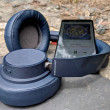Review: Google Pixel 3
Oct 15, 2018, 11:00 AM by Eric M. Zeman

The Pixel 3 from Google is an intelligent phone that wants to help you. The Google Assistant is baked into every facet of the Pixel 3, and together with Android 9 Pie it will learn who you are, what you like to do, and what you need as you move throughout your day. Here is Phone Scoop's in-depth review of Google's most complete product.
Hardware
Is It Your Type?
Google relies on its Pixel phones to showcase their latest software sorcery, while offering a top-notch imaging experience. This is a phone for Android super-fans and purists.
Body
The Pixel 3 represents a clear evolution of Google's hardware design language. It's still identifiable as part of the Pixel family, and yet it stands out as a more cohesive phone with a stronger personality than its predecessors. It's simple and authentic.
We should mention early on the the Pixel 3 and Pixel 3 XL are identical save for the size, screen, and battery. All other internal specs are the same. The only "improvement" you'll see with the 3 XL is a larger display and longer battery life.
The original Pixel and Pixel 2 married metal and glass in an obvious way with a smaller piece of glass that fit into the larger metal frame. Most of the rear panel of those two phones is metal. The Pixel 3's entire rear surface is now a smooth piece of glass with mixed matte and glossy finishes that mimic the look of older Pixels. An aluminum frame forms the chassis, but it's covered with thick, glossy paint that looks and feels like ceramic. I appreciate the curvature of the frame. The front, too, is all glass. Everything about the shape is smooth, rounded, and creamy.
While the rear panels come in white, black, and "Not Pink", the front of all three models is black. I am a fan of the black and white options, but not the pink so much. (To each, his/her own.) I appreciate that the white model has a mint green power key, and the not pink model has an orange power key.
The smaller Pixel 3 is likely the perfect-sized phone for many people. It stands 5.73 inches tall and sits 2.69 inches wide. The narrow body makes it much easier to hold and use when compared to the larger 3 XL, or even the iPhone Xs. It's a comfortable 7.9mm deep, which gives the Pixel 3 a sleek profile. It's about the same size as the Galaxy S9. The phone drops into pockets frictionlessly. You hardly know it's there.
The materials and manufacture are all excellent. Both the front and rear panels are made of Gorilla Glass 5. It's not impervious to damage, so you may want to consider a case. The Pixel 3 may look simple, but it's put together tightly, from high-quality components. The device is protected from dust and water (with an IP68 rating). That means you can drop it in the pool, where it can sit in up to 1.5m (~5 feet) of water for about 30 minutes. I let it sit in a bucket of water and held it under the faucet and it's just fine.
You'll find a prettier face on the Pixel 3 than the 3 XL. Black glass stretches from top to bottom. There are two slits — one near the top and one near the bottom — for the stereo speakers. You can just barely spot the two user-facing cameras in the forehead. Speaking of which, the Pixel 3 has slim side bezels, but a noticeable forehead and chin. These help to exaggerate the elongated look of the phone. At least there's no notch. (While I don't mind notches in general, the notch on the Pixel 3 XL is particularly unappealing. That's why I prefer the look of the Pixel 3.) Thanks to the curved 2.5D glass, there's nothing protecting the screen if you place the phone face down.
The only two physical buttons are on the phone's right edge. The power button is the higher of the two. It has an excellent profile and even better travel and feedback. The green hue on our white review unit makes it easy to spot. The volume toggle is a bit small for my tastes, though its feedback is as good as the screen lock key.
Green Button

A USB-C port graces the bottom edge of the phone. There's no 3.5mm headphone jack. Yes, Google includes an adapter in the box. And yes, Google includes a set of USB-C based ear buds. They're actually pretty decent and allow you to interact with Google Assistant, which is a bonus. But it's still annoying that there's no standard jack.
The SIM card tray is also on the bottom. I can't recall the last time I saw a SIM card tray thusly located. The phone doesn't support memory cards.
USB-C and SIM
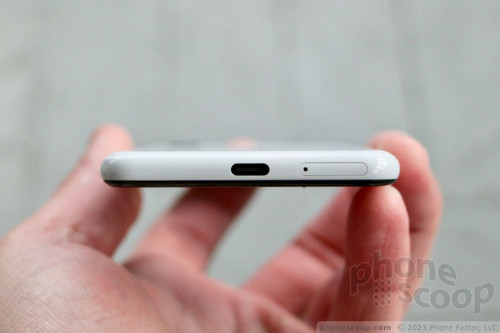
I am particularly impressed by the rear glass. Rather than mix metal and glass, Google went with a single piece of glass that has been etched along the lower portion to give it a matte texture that's more grippy than the polished and smooth upper portion. It feels amazing. This visual trickery also ensures that the Pixel 3 still bears some family resemblance with the older Pixels.
The camera module protrudes a bit from the rear panel, which means the phone won't sit perfectly still on flat surfaces. There's no accessing the embedded battery.
The Pixel 3 isn't perfect, but it's a far more elegant and approachable phone than older Pixel and Nexus models. It also holds up well to competing flagships in terms of quality.
Screen
The Pixel 3 has a 5.5-inch screen, which I find to be too small. Competing phones now put more screen into a body this size. Most devices I prefer now have screens 6 inches and up. The Pixel 3's screen is smaller than those of the iPhone X and Galaxy S9 (both 5.8 inches).
Size isn't everything. This OLED panel has full HD+ resolution with a 2:1 aspect ratio and support for HDR. It's very good, and absolutely destroys the display on last year's Pixels.
The resolution gives the Pixel 3 a pixel density of 439ppi, which is good enough. It means everything you see on the screen is sharp and well-defined. Colors are fantastic. The HDR support and high contrast ratio mean colors pop and blacks are inky. If you have access to HDR content, you'll notice the difference. Brightness is also excellent. I was able to use the screen outdoors under sunny skies without issue. Viewing angles are superb; there's no blue shift nor brightness loss when you tilt the phone.
Options for managing the display include several preset color profiles, aggressive auto-brightness control, and blue light filter / night time settings.
If 5.5 inches doesn't cut it for you, the Pixel 3 XL's display measures 6.3 inches and offers considerably more real estate (despite the notch).
Signal
Google opted for Cat 16 LTE aboard, which supports theoretical maximum download speeds of up to 1Gbps (and 75Mbps uploads). It includes CDMA for use on Verizon, and most of the newest bands for AT&T (29, 30) and T-Mobile (66, 71). We tested it on AT&T and Verizon.
The phone performed very well on both networks. Calls and text messages all reached me with no problem. In fact, the Pixel 3 was a champ at keeping calls connected in moving cars. Data performance was consistent and quick. I saw blazing fast speeds, with the "slowest" peak downloads in the 40Mbps range. No one can complain about that.
The Pixel 3 is stellar for streaming audio and video over the network.
Speed Test
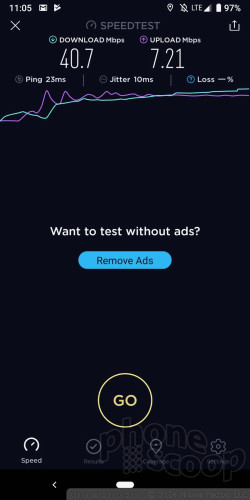
Sound
The Pixel 3 is a good voice phone. Calls in the earpiece are plenty loud and generally free of distortion. I noticed a small amount of popping here and there, but nothing too annoying. Voices sounded sharp and edgy, making them stand out when in loud spaces. People I spoke to through the Pixel 3 said I sounded fine.
If you manage to activate WiFi calling on AT&T, you'll note a significant increase in call clarity. It's crazy how clear these calls are.
Calls pushed to the speakers do well, though they are more prone to distortion when the volume is set all the way up. You can use the speakerphone effectively in your home, office, and in the car. I found it performed well in outdoor spaces too, such as windy city sidewalks.
Ringers and alerts are more than adequate at grabbing your attention. The vibrate alert could be a little stronger.
The Pixel has dual front-firing speakers for stereo sound. This is a feature I've come to really appreciate on phones. It's great for when you're watching video content with a stereo soundtrack. The speakers are loud enough for your living room or kitchen, but they start to get lost outside. You might be able to spread sound around a small/medium deck. The quality is fine considering how small the Pixel 3 is.
Battery
The battery is one component that's significantly different between the 3 and 3 XL.There's only room for a 2,915mAh capacity battery in the Pixel 3, where the 3 XL can accommodate a 3,430mAh power supply. How does the smaller battery in the 3 do? Admirably.
Over several days of testing I found I was rarely able to get the phone to drop below the 50% mark. I used it extensively for five days and it powered through hours of use without blinking. It's worth noting that Android 9 Pie includes an adaptive battery tool called Ambient Battery that puts unused background apps to sleep so they stop sapping power. Further, the phone goes into hibernation overnight. You can get eight hours of sleep and wake up to find your Pixel 3 has used only a few percentage points of battery. I would say you can bank on a full day of use with no problem.
If you do find yourself lacking power, you can take advantage of the low-power mode to conserve battery life. Unlike older tools that limited you to either 5% or 15% as the low-battery threshold, the Pixel 3 allows you to dial in exactly when low-power mode kicks in. Want the battery saver to turn on when the battery reaches 7%? 11%? Go for it.
For the first time, the Pixel series supports wireless charging. The 3 can grab power from any Qi-based charger. If you use the Google-designed Pixel Stand (read our separate review here), you'll see the phone power up rapidly. It takes about 100 minutes to get a full charge, and you should see a huge bump in just 15 minutes.
Bluetooth, GPS, NFC, WiFi
The Pixel 3's Bluetooth 5.0+LE radio connected to a wide range of accessories. It had no trouble managing headphones for calls or music. Calls made via Bluetooth headsets bordered on excellent. Calls routed to my car's hands-free system were better than average. Music sounded very good through Bluetooth headphones and speakers. The phone also managed to maintain a connection to an Android smartwatch throughout the day.
The GPS radio was quick and accurate. The Pixel 3 often pinpointed me within a blink or two and was precise to within about 10 feet. The phone was a fine navigation tool.
With NFC aboard, you can use the Pixel 3 to make mobile payments via Google Pay. I found it worked well at my local QuickChek. The NFC radio also helps pairing with some Bluetooth accessories.
The Pixel 3's WiFi radio is very, very good. It falls under the new "WiFi 5" category and supports both 2.4 GHz and 5 GHz connections.
Software
Lock Screen
The Pixel 3's lock screen is very good. It includes Google's take on the ambient display, which means the time, date, weather, notifications, and battery life are all visible in white text on the black screen. I like that you can set the ambient display to be on all the time, or just when you double tap the phone and/or lift it up. As always, you can take full control over notifications and how they appear on the lock screen. 'Tis good, 'tis good.
If you're a music fan, you can turn on Google's song recognition tool. With this feature enabled, the phone is always listening. It can identify most modern music in the background and let you know the song and artist. Of course, you can tap to find the song for sale in the Google Store. Google says it's able to do this without draining power and that seems to be the case.
As for security, there's a fingerprint reader on the rear. It's well-positioned and easy to activate without looking. Set-up is quick and it performs very well. You can always opt for a PIN, pattern, or password.
Curiously, the Pixel 3 doesn't have any sort of facial recognition for security purposes. This is in direct contrast to Apple and Samsung (and others), which include this feature on their flagship phones.
Home Screens
Android 9 Pie is the most recent version of Android from Google and that's what's aboard the Pixel 3. If you're coming from a Pixel or Pixel 2, you'll see that not much is different from the version of Android Pie on your existing device.
The biggest change is home screen navigation. The Pixel 3 ships with Google's swipe-based UI as the default. You'll see a small "pill" icon at the bottom of the screen. Long press the pill to open Google Assistant, swipe up once to see recent apps, swipe up again to see the app drawer, or flick it to the right to quickly jump backward through apps. I like this last gesture, but the double swipe needed to get to the app drawer is just awful (and we told Google execs that in May). It's not as smooth or intuitive as the swipey UI on Apple's iPhone Xs or even the OnePlus 6. It's a tough pill to swallow, but this is something you're going to have to deal with.
One you get past the pill, the rest of the Pixel 3's home screen experience is the same as most other Android phones. You've got customizable home screen panels, your Google Feed on the far left, a notification / Quick Settings shade, and an app drawer. The app drawer doesn't support folders, but the home screen panels do.
Pie has one behavior worth calling out. In the app drawer you'll begin to see suggested actions near the shortcuts at the top. For example, if you call Mom once a day the Pixel 3 may suggest you call her and provide a one-touch button to do it. That's neat, but I've also noticed it picks up on the wrong things sometimes, such as suggesting you open a web site you've only ever visited once.
The Pixel 3 includes an interesting call screening tool. The phone gently suggests you activate it when you use the phone app to make calls. It works like this: A suspect call rings your phone, Google labels it as possible spam, and you send it to the screener. Google will answer the call and explain to the caller that you're screening the call. It will then give the caller a chance to talk. All of this is transcribed in real time so you can see the convo on the screen. If it's someone you wish to speak with, tap to connect the call. Otherwise, you can tap to disconnect and block the number.
I get two to five spam calls every afternoon / evening, and I found Google was able to do a really good job of identifying which ones were spam. The transcription wasn't always quick or 100% accurate, but it was good enough to let me know I didn't need to talk to a robot about that Caribbean cruise.
Digital Wellbeing is a major new feature of Android 9, but it's something you have to find and turn on yourself; the phone doesn't suggest it. Digital Wellbeing is meant to help you put the phone down and use it less.
First, it counts how many times you pick up the phone, how many times you unlock it, how many notifications you receive, and how much time you spend in various apps. This can be eye-opening.
Unlock

Second is Wind Down, which activates a night-time routine for the phone. It will dim the screen, enter Do Not Disturb mode to quiet those notifications, and then, at a predetermined time, enter grayscale mode. Nothing makes me want to stop looking at my phone quicker than when the screen goes grayscale. Google hopes that, all together, these tools will provide insight and eventually coax people into adjusting their behavior. You can ignore all of it if you want.
Wind Down

The Pixel 3 runs on a Snapdragon 845 processor. It's paired with a head-scratching 4 GB of RAM. Most other flagships in this price class have 6-8 GB of RAM. It's a bit baffling that Google opted for a lower amount of RAM. Even so, the Pixel 3 runs well. I didn't notice any real problems or hiccups. It might not be the best gaming phone, but all other apps opened quickly and performed appropriately. It's snappy, and in line with devices like the V40, Note9, and others.
Camera
If there's one app that's definitely different amongst the Pixel family, it's the camera. Google has updated the layout for the Pixel 3 in order to take advantage of some new modes.
The fastest way to open the camera is to double-press the lock button. You can also open it from the home screen, or ask Google Assistant to open it. The app springs to life in an instant.
The layout is fairly standard for a modern camera app. Four modes are easy to jump to from the main screen: panorama, portrait, camera, and video. The rest of the modes are buried under a tab that says "more." These additional modes offer photo sphere, slow motion, Photobooth, Playground, and Lens.
Motion Photos are like Live Photos on the iPhone. The Pixel 3 captures a couple of seconds of video when you press the shutter button. You can then save the file as a GIF and send it to others. I like that there are three settings here: on, auto, and off. The auto mode will have the Pixel 3 capture video if it senses motion, such as kids jumping around. If you're taking a pic with no motion in it, the phone will take a normal photo.
Slow Motion offers two capture speeds: one-quarter (120fps) or one-eighth (240fps). That's not as impressive as the insane 960fps option that Samsung and Sony offer, but it's still fun to play around with.
Photobooth is for fun selfies. It takes four shots when it senses smiles, allowing you and your friends to change poses in between pix. A couple of bummers: You have to smile to get it to work — which means no serious poses, smokey looks, or other funny faces — and it doesn't compile the results in an old-timey photobooth strip. That's a total missed opportunity.
Photobooth
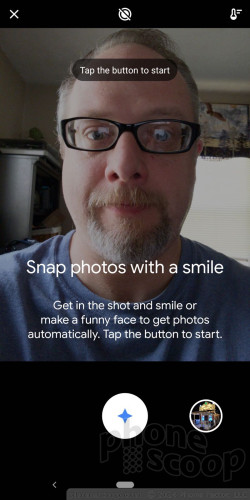
Playground is the renamed AR Stickers mode. It lets you drop stickers into your photos or videos. There are tons of sticker packs available, with some cool new ones from the Marvel and Stranger Things universes. The vast majority of stickers are animated and dance around. You can also generate animated text boxes. This is great for entertaining kids, or having a kid-at-heart moment.
Google Lens is, of course, Google's visual search tool. It is baked directly into the camera and lets you search for things in a snap. The tool has expanded its ability to recognize objects and text, meaning it's more useful than older builds. You can use it to search for products, identify plants and animals, scan QR codes, and discover books/movies. It's quick and helpful.
Google Lens
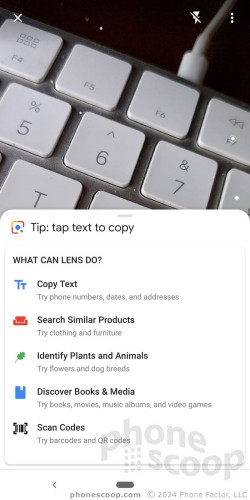
The settings let you tap into some extra tools. For example, you can turn on RAW mode and record videos in the more efficient H.265/HEVC format. RAW is particularly helpful when you're going to edit photos on a desktop.
The selfie camera includes the majority of these tools and adds the option to turn on beautification if you wish.
It's somewhat surprising to me that Google doesn't include a manual mode, but the phone's "computational" photography is so good I doubt you'd get better results adjusting things on your own. Even so, this does take away some creativity. You'll also have to rely on third-party software if you want to capture timelapse video.
Photos/Video
There's a lot going on with the Pixel 3's cameras. In a time when most flagship phones are shipping with two or three (or more) rear cameras, Google is sticking to one. There's a single 12.2-megapixel sensor on the rear at f/1.8 and a field-of-view of 76 degrees. It includes optical image stabilization and can snag 4K video if you wish.
Like the original Pixel and Pixel 2, the camera on the Pixel 3 is a stunner. Google's algorithms are simply superior. The majority of shots I captured with the phone are fantastic. The low-light shots (see the dusk-y firehouse) are the most impressive. This is possible in part thanks to Google's HDR+, which now takes and merges an even broader range of exposures to get the perfect result.
Portrait photos are particularly impressive. The phone does a fine job of defining the subject and ensuring that the border between subject and background is in the right spot. Google's portraits look less janky when compared to results from Apple, Samsung, and LG. I also like that you can adjust the blur after the fact.
Google's software is better at stitching together panoramas and photo spheres (360-degree images) than competitors.
I like that Google is easily able to turn the Motion Photos into shareable files. The results depend a lot on your timing, but you can tweak them just a little in Google Photos before sending them to friends.
Google did choose to put two cameras on the front of the phone. Both have 8-megapixel sensors. The main lens shoots 75-degree shots at f/1.8, while the second shoots 97-degree shots at f/2.2. An on-screen toggle lets you easily jump between the two. The wide-angle is for those moments when you want to capture a Group Selfie (Groufie), or want to get more of the background in the frame. The results are excellent.
Portrait

The selfie cameras can also capture very good portrait shots. The selfie camera doesn't have a dedicated flash, but it will use the screen to brighten things up when necessary.
Portrait 2

As for video, the phone captures footage up to 4K in resolution (up to 1080p on front). The video I took looked very good, particularly in low light situations. I was most pleased with the lack of grain and noise. Color looks good and so does exposure.
The Pixel 3 (and 3 XL) offer the best camera on a mobile device today.
Consider the fact that Google allows Pixel owners to upload unlimited full-resolution images and videos to Google Photos for safekeeping, and you have a winning combo.
Google Assistant
Google Assistant is baked into everything on the Pixel 3. The most obvious is via the squeezable side edges, something carried over from the Pixel 2. Using the settings, you can enable and adjust this tool. Set it to activate on gentle, medium, or firm squeezes. You do need to squeeze both sides together. Opting for the firmest setting prevents misfires when you're holding the phone, but requires more effort to activate.
If you don't want to mess with the squeezable sides, you can always holler "Hey Google" and the phone will jump to life, even when locked. Google Assistant is always at your beck and call. And of course, a long press of the pill at the bottom of the screen always activates Google Assistant no matter what app you might be in.
Google's latest tagline is "Make Google Do It". Indeed, the Pixel 3 will, if you ask. I found Assistant to be very responsive to voice requests. Your success with results still depends on the query, connectivity, and how much permission you choose to give Google concerning your everyday life.
Wrap-Up
There's no question in my mind that the Pixel 3 is one of the best options in the flagship phone market right now. Whether you want to go small with the 3 or large with the 3 XL, you're in for an enjoyable experience. The Pixel 3 has a more compact and usable footprint, but not the battery life and cinematic screen available on the 3 XL. Everything else between the phones is identical.
Google did a great job with the hardware. The phone borders on the simplistic as far as design is concerned, but I consider that a strength in this case. (It's never been about the hardware, anyway, as far as Google is concerned.) I particularly find the all-glass build appealing, and table-stakes features such as water resistance are on board.
Google's newest version of Android is an excellent platform for a mobile device. The base user interface is as easy to use as ever, and Pie delivers tasty new tidbits such as Digital Wellbeing, Ambient Battery, and Ambient Display. Having a "pure" version of Google's excellent software is a big plus. The Pixel's own additions, such as Call Screening, are truly useful at cutting junk from your life.
Then there's the camera. Google has crafted yet another winner. Its engineers are able to work magic to create some of the best images I've seen from a phone. If you're serious about getting the best shot with minimal fuss, the Pixel 3 and 3 XL are here for you.
You'll pay for all this awesomeness. The 64 GB Pixel 3 costs $799 and the 128 GB costs $899. The 64 GB 3 XL costs $899 and the 128 GB model costs a painful $999. These prices are ridiculous compared to last year's models, but in line with the competition. If you can, trade in your old phone. Right now, Google will give you between $200 and $335 for your old Pixel 2 XL. That goes a long way to making the Pixel 3 more affordable.
This is one phone that's worth the investment.
Comments
Editors Choice?
























































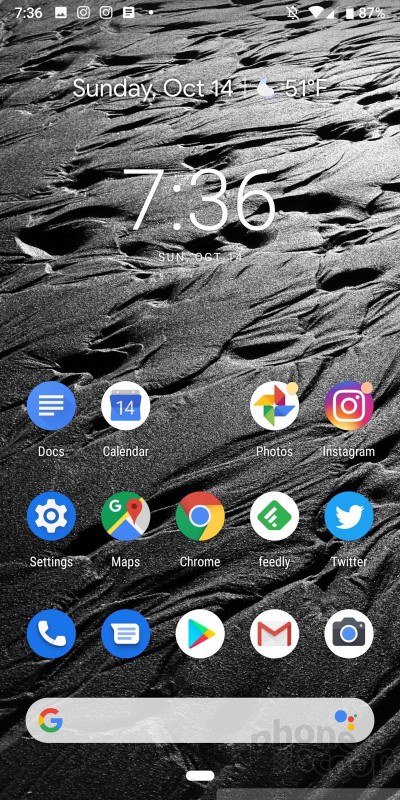






















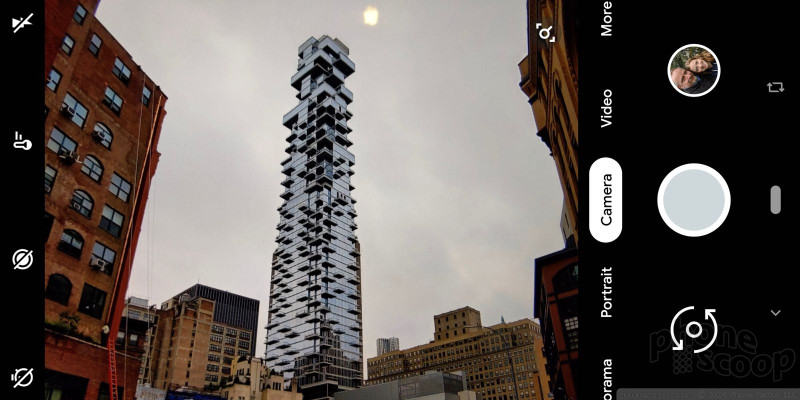













































 Review: Moment Case and Lenses for Google Pixel 3
Review: Moment Case and Lenses for Google Pixel 3
 Review: Google Pixel Stand Wireless Charger
Review: Google Pixel Stand Wireless Charger
 Hands On with the Google Pixel 3 and Pixel 3 XL
Hands On with the Google Pixel 3 and Pixel 3 XL
 Google Feature Drop Brings New Smarts to Pixels
Google Feature Drop Brings New Smarts to Pixels
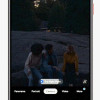 Google Turns On the Night for Pixel Phones
Google Turns On the Night for Pixel Phones
 Google Pixel 3
Google Pixel 3
 Google Pixel 3 XL
Google Pixel 3 XL


